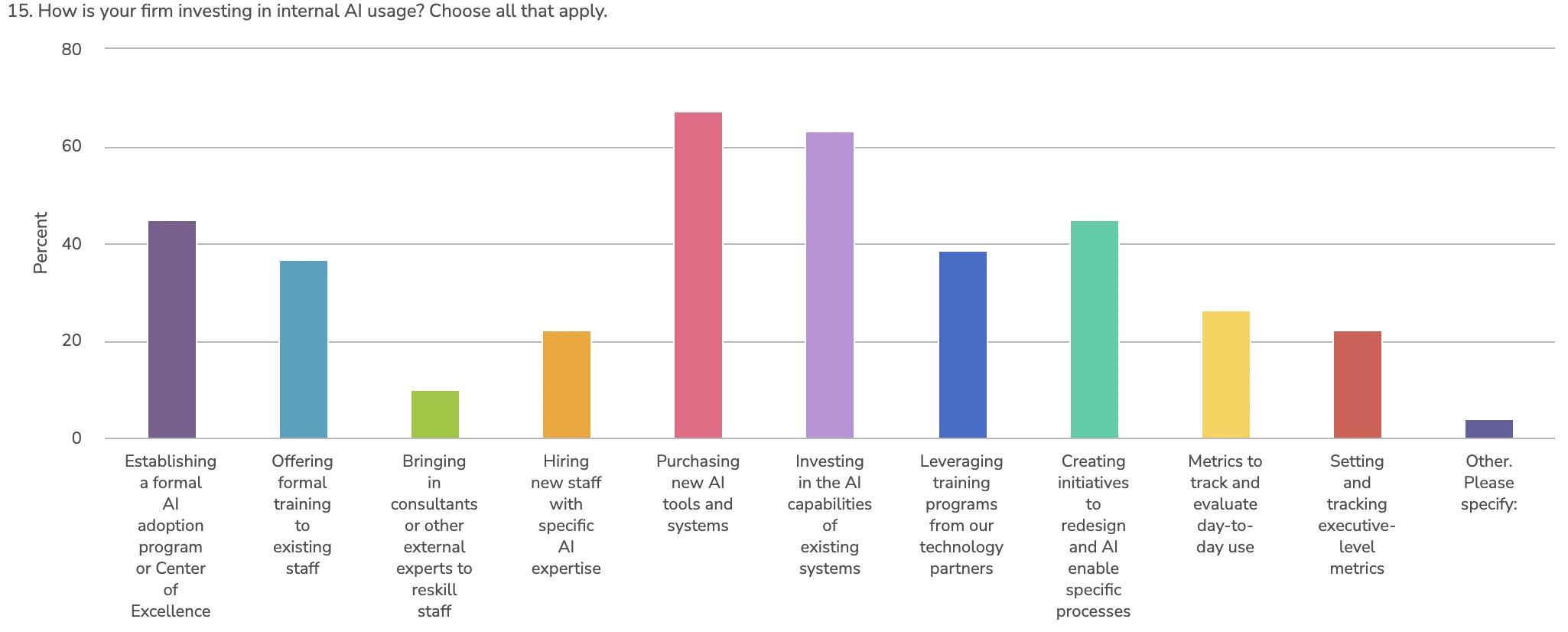Everyone is talking about how AI will change the way we work, how businesses operate and which jobs will survive and thrive in an AI Era. Nowhere is that more apparent than in IT services.
Today, professional services firms seem to be focusing in three areas: What services can we provide around AI that our customers will value? How are we meeting our partners’ needs and expectations with their AI solutions? How can we use AI to do what we do better, faster, cheaper?
I’d like to offer up a fourth focus area that needs to be addressed by any professional services company that wants to stay ahead of the AI curve: how will you differentiate based on how your teams learn?
Technology certifications used to be differentiators, now they are table stakes. The basic functional and industry knowledge required to do certain jobs is now available at scale through GenAI. AI isn’t just changing what your employees need to know or what tools they use; it is transforming the fundamental nature of how your teams will learn, develop, and demonstrate expertise in a way that is unique to your company.
The Problem: Everyone’s Busy Training on AI, But Not Strategic About It
Your people need to know how to use AI, in all its various forms. If you’re slightly ahead of the curve, you’ve done things like introduced training classes and held “AI Innovation Days” and AI hackathons. A recent Tercera survey of IT services leaders indicates that almost every single firm is making some internal investment in AI capabilities – from creating formal adoption programs to buying new AI tools (see below).

Everyone’s busy with AI. But busy isn’t the same as effective. The question isn’t whether your people can use AI tools; the challenge will be teaching your people to learn differently when AI handles the knowledge work. The real questions are: “Are any of these things helping me win because my people can do things that others can’t? Are they helping my teams think and learn better (not just faster)?”
Why Learning Differently Matters
To understand why this matters, I need to show you how learning actually works – and bear with me while I show you how big a nerd I am.
I am a HUGE Star Trek fan. I’ve always been fascinated by how the crew uses the computer (AI at its finest) for information, analysis and to perform mundane-to-battle-ready tasks. At the same time, the crew are incredibly educated and constantly rely on their intuition and ability to connect unrelated dots to form hypotheses and solve that week’s dilemma.
This works because – even in space – this is how people actually learn:
- Factual and procedural knowledge – the mental shortcuts you can draw on without having to look things up
- Conceptual knowledge – what enables your teams to understand business use cases and shape solutions through various mental models
- Metacognition – understanding your own thought process and using that understanding to deepen learning
Your approach to AI right now is probably dealing with facts and procedures. There are incredible benefits to presenting information in the right context, enhancing workflows, and removing mundane work. But as valuable as that is, it is ultimately about productivity and will become ubiquitous.
Focus on teaching your employees HOW to learn with AI to make your people your competitive edge.
Your task is to realize the metacognitive shift required when knowledge acquisition is transformed and develop learning strategies that leverage AI to build unreplicable expertise. In non-learning-geek language? Focus on teaching your employees HOW to learn with AI to make your people your competitive edge.
Three Ways to Make Learning Your Differentiator
- Develop proprietary perspectives, not just AI skills. What are the viewpoints, frameworks, or success stories that define what is unique about your organization? This isn’t about teaching AI as a tool—it’s about teaching AI as a thinking partner. Use it to pressure-test your perspectives, to explore scenarios your competitors haven’t considered, to uncover blind spots in your approach.
- Get the productivity gains, then get serious about the learning gains. Push hard to get to AI as coach, tutor, mentor, and devil’s advocate. This shift from AI-as-efficiency-tool to AI-as-learning-amplifier is where the real competitive advantage lies. Stop talking about “growth mindset” and start expecting your people to use AI to become better thinkers, not just faster workers.
- Flip the hiring script—creativity and relationships are your new technical skills. Talent retention in professional services just got harder because when AI is doing the repetitive work, it will shine a spotlight on those that truly add value. Those are the employees your competitors will want the most and the ones you need to keep. One of your most valuable retention tools is a new learning strategy. Step away from competency models that prioritize technical depth and start building teams around the ability to build sticky relationships, communicate complex ideas, and innovate with AI as a collaborator.
The Collective Intelligence Advantage
Everything I’ve said up to this point has been about the individual. But here’s the counterintuitive reality: As AI makes individual expertise more accessible, collective intelligence becomes more valuable. The firms winning tomorrow won’t just have smart people, they’ll have people who make each other smarter.
When everyone has access to the same foundational knowledge through AI, the competitive advantage shifts to how well teams can combine their unique perspectives, challenge each other’s assumptions, and co-create solutions that no individual (or AI) could produce alone.
When everyone has access to the same foundational knowledge through AI, the competitive advantage shifts to how well teams can combine their unique perspectives, challenge each other’s assumptions, and co-create solutions that no individual (or AI) could produce alone.
Think about it: your clients aren’t just buying your technical capability anymore. They’re buying your ability to see connections across disciplines, to bring together diverse viewpoints, and to synthesize complex challenges into actionable strategies. That synthesis happens in the spaces between people, not within individual minds.
While your competitors are training individuals to use AI better, you’re building networks that think together. That’s not just a capability. It’s a moat.
The Choice Ahead
We’re witnessing an organizational identity crisis. Companies are frantically reorganizing around AI. We’re creating Chief Work Officers, resurrecting Chief Learning Officer roles, launching endless training programs. But in all this scrambling to teach people how to use AI, we’re missing the deeper question: What happens when everyone has the same AI capabilities?
The firms that survive won’t be the ones with the best AI training programs. They’ll be the ones who figured out how to make their people’s thinking irreplaceable.
If AI democratizes knowledge, what becomes the new scarcity? The answer is wisdom work—the kind of thinking that emerges when humans and AI collaborate not just to process information, but to create genuinely new insights.
Knowledge work is becoming wisdom work. It’s kind of exciting to see people come front and center in all the conversation about how AI is transforming work. I’d love to hear from you about what you are doing to differentiate your professional services firm and what your teams are learning.
Cat Lang is a Tercera Advisor and has helped build skilled customer and partner workforces in the Cloud world before it was called Cloud. She has led groundbreaking training, certification, and customer success initiatives at global Cloud leaders including Salesforce, Google, and ServiceNow.

